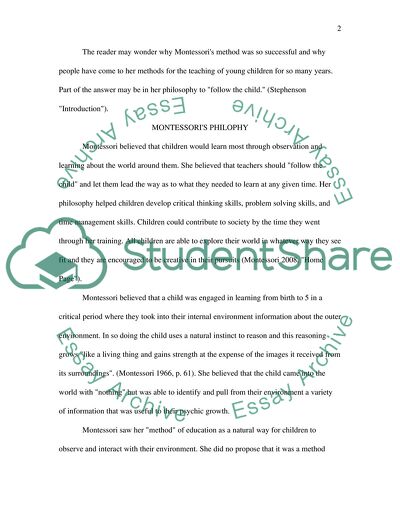
- Home
- Free Samples
- Premium Essays
- Editing Services
- Extra Tools
- Essay Writing Help
- About Us
- Studentshare
- Subjects
- Miscellaneous
- Outline and discuss some of Maria Montessori's most significant ideas about childhood and education
Outline and discuss some of Maria Montessori's most significant ideas about childhood and education - Essay Example

- Subject: Miscellaneous
- Type: Essay
- Level: Undergraduate
- Pages: 4 (1000 words)
- Downloads: 0
- Author: hstoltenberg
Extract of sample "Outline and discuss some of Maria Montessori's most significant ideas about childhood and education"
Her initial work was done in Rome at the University of Rome. When she was 28 years old she became the head of a school that taught mentally retarded children. Two years later these children were able toe take a test with normal children and pass (Stephenson 2008 "A Brief Biography"). Previous to this time these children were thought to be unteachable. Montessoris response was to go back to school to study psychology and anthropology so that she could understand how "normal" children worked. In 1907 she would take charge of 50 children in the Roman slums.
She was so successful in her work with these children that she was asked to setup her classroom at the Panama-Pacific International Exposition in San Francisco in order to show her methods to a larger group of teachers and individuals (Stephenson "A Brief Biography"). She created a four month experiment using 21 children who attended for the duration of this time. She received two gold medals for her efforts. The reader may wonder why Montessoris method was so successful and why people have come to her methods for the teaching of young children for so many years.
Part of the answer may be in her philosophy to "follow the child." (Stephenson "Introduction"). Montessori believed that children would learn most through observation and learning about the world around them. She believed that teachers should "follow the child" and let them lead the way as to what they needed to learn at any given time. Her philosophy helped children develop critical thinking skills, problem solving skills, and time management skills. Children could contribute to society by the time they went through her training.
All children are able to explore their world in whatever way they see fit and they are encouraged to be creative in their pursuits (Montessori 2008, "Home Page"). Montessori believed that a child was engaged in learning from birth to 5 in a critical period where they took into
...Download file to see next pages Read MoreCHECK THESE SAMPLES OF Outline and discuss some of Maria Montessori's most significant ideas about childhood and education
Gender and Play within the Foundation Stage
Reflective Journal Portfolio Analysis
Maria Montessoris work
Treating learning disabilities
Learning Through Touch
Integration in Early Childhood Education
Maria Montessori's Theory of Education
Early Childhood Education

- TERMS & CONDITIONS
- PRIVACY POLICY
- COOKIES POLICY